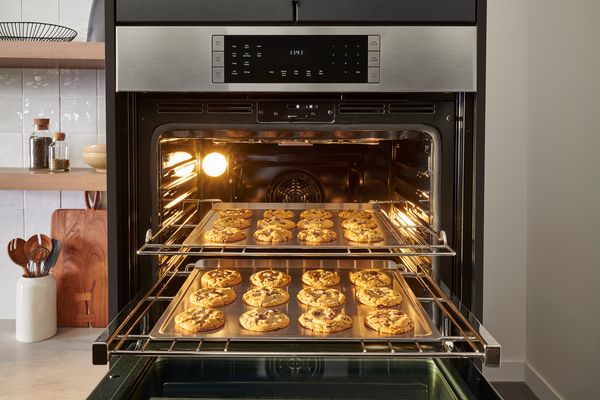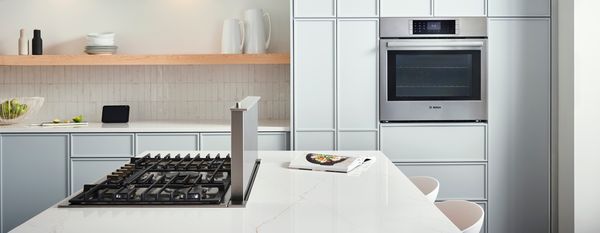In the dynamic world of kitchen appliances, Bosch has steadily become a trusted name synonymous with craftsmanship and innovation. With a legacy that spans over a century, we've listened to the needs of our customers, seeking to enhance every culinary experience. One such innovation that has garnered attention is the convection oven.
A convection oven is more than just a luxury addition to your kitchen; it's a game-changer. By leveraging advanced technology to circulate heat more evenly, it promises consistent results and heightened culinary precision. Join us as we explore the mechanics behind this appliance and discover how it can transform your cooking.
Types of Convection Ovens
1. Regular Convection Ovens: These ovens possess a fan that circulates air around the oven. This movement ensures an even distribution of heat, leading to more consistent cooking results.
2. True Convection Ovens: The Bosch 800 Series and Benchmark Series wall ovens come with Convection Pro, which is slightly different from regular convection ovens. Apart from the fan, true convection ovens, like Bosch ovens with Convection Pro, feature an additional heating element located behind the fan. This means the oven doesn't just circulate the existing hot air; it also blows heated air onto the food, resulting in even faster and more uniform cooking.
How Do Convection Ovens Compare to Other Appliances?
The kitchen is a haven of diverse appliances, each offering unique capabilities. Among these, convection ovens have carved a niche for themselves, known for their efficiency, and even cooking. But how do they measure up against other kitchen stalwarts? Let's dive into a comparative analysis.
Convection Ovens vs. Conventional Ovens
While both convection and conventional ovens are staples in many kitchens and share a common goal of cooking and baking food, their operational nuances differ:
1. Heating Mechanism:
- Convection Ovens: These ovens are equipped with one or more fans that actively circulate hot air around the food. This circulation ensures that heat is distributed more evenly throughout the oven's interior.
- Conventional Ovens: Unlike the fans found in convection ovens, conventional ovens rely on radiant heat emanating from heating elements or burners. Heat rises to the top, making the oven's upper portion hotter than the bottom.
2. Cooking Time & Efficiency:
- Convection Ovens: The active circulation of hot air means that foods often cook faster in a convection oven. This efficiency can lead to significantly reduced cooking times.
- Conventional Ovens: Without air circulation, these ovens might require longer cooking times, especially for larger dishes or items placed farther from the heating element.
3. Cooking Consistency:
- Convection Ovens: The even distribution of heat can lead to more uniform baking and roasting results, reducing the likelihood of hotspots or unevenly cooked sections.
- Conventional Ovens: Due to the stationary nature of the heat, there might be areas in the oven that are hotter than others, leading to potential uneven cooking or browning.
4. Temperature Management:
- Convection Ovens: Because they cook food faster, recipes designed for conventional ovens might require a temperature adjustment (usually a reduction) when using a convection oven.
- Conventional Ovens: Recipes are generally standardized for these ovens, so there's less guesswork involved in setting the temperature.
It’s also important to note that there are multiple types of convection ovens:
5. Regular Convection Ovens: These ovens possess a fan that circulates air around the oven. This movement ensures an even distribution of heat, leading to more consistent cooking results.
6. True Convection Ovens: The Bosch 800 Series and Benchmark Series wall ovens come with Convection Multi-Rack, which is slightly different from regular convection ovens. Apart from the fan, true convection ovens, like Bosch ovens with Convection Pro, feature an additional heating element located behind the fan. This means the oven doesn't just circulate the existing hot air; it also blows heated air onto the food, resulting in even faster and more uniform cooking.
Convection Ovens vs. Air Fryers
Cooking Mechanism: While both employ hot air circulation, air fryers operate at higher speeds, focusing on rapid air circulation to achieve that coveted crispy exterior typical of fried foods. Convection ovens, though they also circulate air, do so in a manner suited for a wider variety of cooking techniques beyond frying.
Size & Capacity: Convection ovens are generally larger and can accommodate bigger dishes or multiple items simultaneously, making them suitable for preparing meals for families or gatherings. In contrast, air fryers are more compact, often designed for countertop use, and are ideal for smaller portions or quick snacks.
Versatility: While convection ovens can handle everything from roasting to baking, air fryers are primarily known for delivering fried-like textures, making their cooking scope much more limited compared to convection ovens.
Some ovens, like the Bosch 800 series and Benchmark all-in-one ovens come with a built-in air fryer.
Convection Ovens vs. Convection Microwaves
1. Cooking Process:
- Convection Ovens: These ovens utilize a heating element to produce heat, and a fan circulates this heat throughout the oven. This circulating hot air cooks food more evenly and often faster than a conventional oven.
- Microwaves (including Convection Microwaves): Microwaves cook food by emitting microwave radiation, which agitates water molecules in the food, producing heat. This method heats food from the inside out. In convection microwaves, there's an additional feature: a heating element and fan, similar to a convection oven, which can be used to bake and roast foods more traditionally.
2. Consistency & Precision: While a convection microwave offers the quick heating of a microwave and the even cooking of a convection oven, it might not always match the precision of a standalone convection oven, especially for elaborate dishes.
3. Speed vs. Quality: Microwaves are designed for rapid heating, making them great for reheating leftovers or quickly cooking certain foods. Convection ovens, on the other hand, emphasize even cooking and texture, often desired for baking and roasting.
4. Versatility: Convection ovens excel in tasks like baking, roasting, and broiling, offering a wide range of cooking styles. Convection microwaves, with their dual functionality, offer the convenience of rapid microwave cooking and the traditional cooking style of an oven.
How to Use a Convection Oven
Navigating the world of convection ovens might seem daunting at first, but with a few guiding principles, you'll soon master the art of convection cooking. Here's what you need to know:
When to Use a Convection Oven
Convection ovens shine in scenarios that require even and quick heating. They are ideal for roasting, as the circulating air crisps up the exterior of meats and vegetables while still locking in the moisture. If you're baking on multiple trays, the uniform heat distribution ensures consistent results across all of them. Those dishes that benefit from a crispy or caramelized exterior, like gratins or pies, will find a perfect partner in convection ovens. Additionally, if you're into dehydrating foods, the air circulation of a convection oven ensures even drying.
When Not to Use a Convection Oven
- Delicate Bakes: Items like flans, soufflés, or cakes that rise might be negatively affected by the air circulation, leading to uneven rising or surface cracks.
- Certain Custards: The circulating air can create a “skin” on custards or puddings.
- Recipes Not Adjusted for Convection: Most recipes are created for conventional oven settings. If you haven’t adapted a recipe for convection cooking, it might not yield the expected results without adjustments.
Adjusting Recipes for Convection Ovens
Adapting recipes for a convection oven can seem intimidating, but with a few key considerations, you'll be able to harness its full potential. Here's what you need to keep in mind:
1. Temperature Reduction: A general rule of thumb for convection ovens is to decrease the temperature by about 25°F (around 15°C) compared to what's recommended for conventional ovens. The circulating air in convection ovens distributes heat more efficiently, so a lower temperature is often sufficient to achieve the desired cooking results.
2. Adjust Cooking Time: Due to the efficient heat distribution, foods often cook faster in a convection oven. Depending on the dish, you may need to reduce the cooking time by 10% to 25%. It's always a good idea to start checking your dish a bit earlier than the original recipe suggests to prevent overcooking.
3. Moisture Consideration: The circulating air in a convection oven can sometimes dry out foods quicker than a conventional oven. For dishes that require moisture, consider adding a water bath or using a covered dish.
4. Fan Speed & Settings: Some advanced convection ovens allow you to adjust the fan speed. A slower fan speed might be more suitable for delicate dishes like pastries or cakes to prevent them from developing a crust too quickly, while a faster speed can be ideal for roasting.
5. Observation & Notes: The first time you adapt a recipe for convection cooking, keep a close eye on the dish's progress. Make notes on temperature adjustments, cooking times, and any other changes you make. Over time, this will help you develop a better intuition for convection cooking and reduce the guesswork.
6. Recipe Testing: If you're uncertain about how a dish will turn out, consider doing a test run, especially if preparing for a special occasion. This allows you to tweak the recipe as needed before the main event.
Which Dishware to Use in a Convection Oven
Your choice of dishware can influence the outcome of your cooking. Low-sided pans are preferred as they promote better air circulation around the food. While oven-safe glass and ceramic dishes are suitable, they retain heat, possibly requiring slight adjustments in cooking times. Regardless of the dish type, avoid overcrowding to maintain efficient air circulation.
Where to Position Dishes
Positioning is vital in convection cooking. For a single tray or dish, the center of the oven is ideal. If you're using multiple racks, ensure there's enough space between trays, and consider rotating them midway for even results. Being able to easily view your dish aids in monitoring its progress, so try to position it for optimal visibility.

Convection Oven Recipes
While some of these recipes may need to be adjusted slightly for convection cooking, using the directions previously mentioned in the post, these dishes are all great options to test out your convection oven:
Bosch Convection Ovens
In the culinary arts, the tools you employ can be as pivotal as the skills you've honed. A convection oven, with its promise of even cooking and efficiency, can be a game-changer in your kitchen endeavors. Bosch, with its legacy of craftsmanship and innovation, offers a range of convection ovens designed to meet the highest standards of performance and elegance.
Whether you're an amateur cook or a seasoned chef, our ovens are crafted to enhance every culinary creation. Discover the Bosch difference and lift your cooking experiences to new heights with our range of ovens.
Convection Oven FAQs
Convection ovens come in various sizes to cater to different culinary needs. There are three main types: countertop convection ovens or half size convection ovens, full sized convection ovens, and commercial convection ovens that are normally found in restaurants.
Typically, you'll reduce the temperature by about 25°F compared to a conventional oven. As for the cooking time, a reduction of 10% to 25% is a common guideline.
Yes, convection ovens are generally more energy-efficient than their conventional counterparts. The fan-assisted circulation of hot air means food cooks faster and at lower temperatures.
In most convection ovens, the primary heating element is located at the bottom. In "true convection" or "European convection" ovens, there's an additional heating element situated behind or around the fan.
Convection ovens, while efficient, can affect delicate bakes due to air circulation and may dry out some foods faster. New users face a learning curve, and these ovens often come with higher purchase and maintenance costs.




